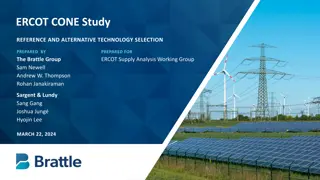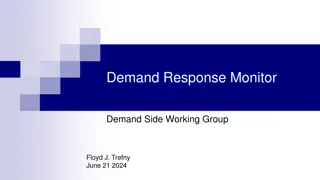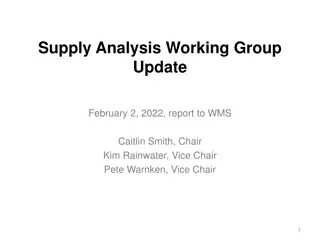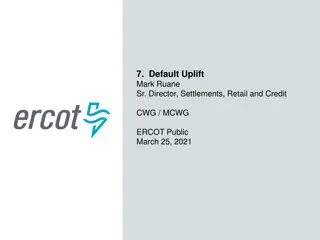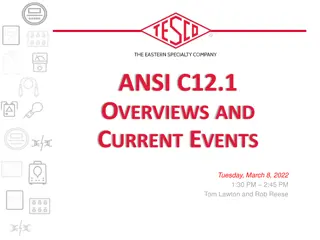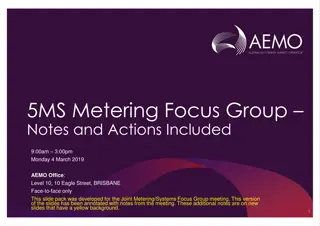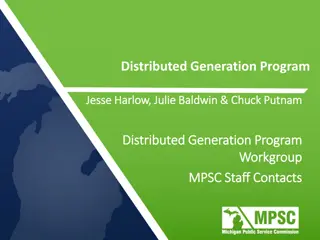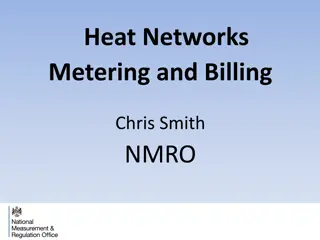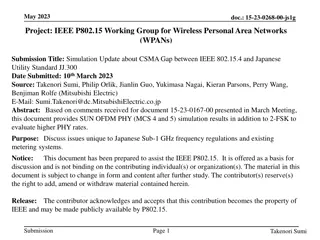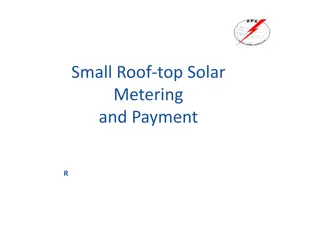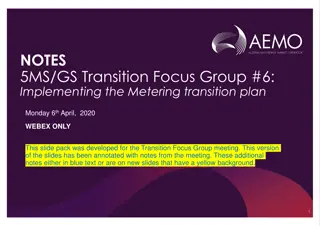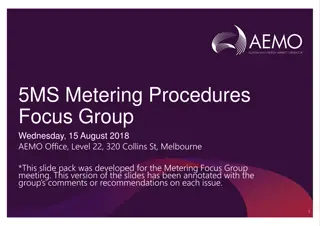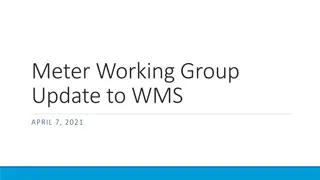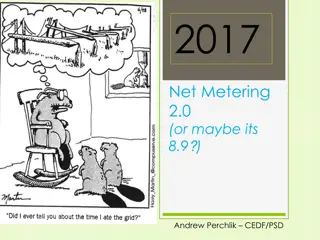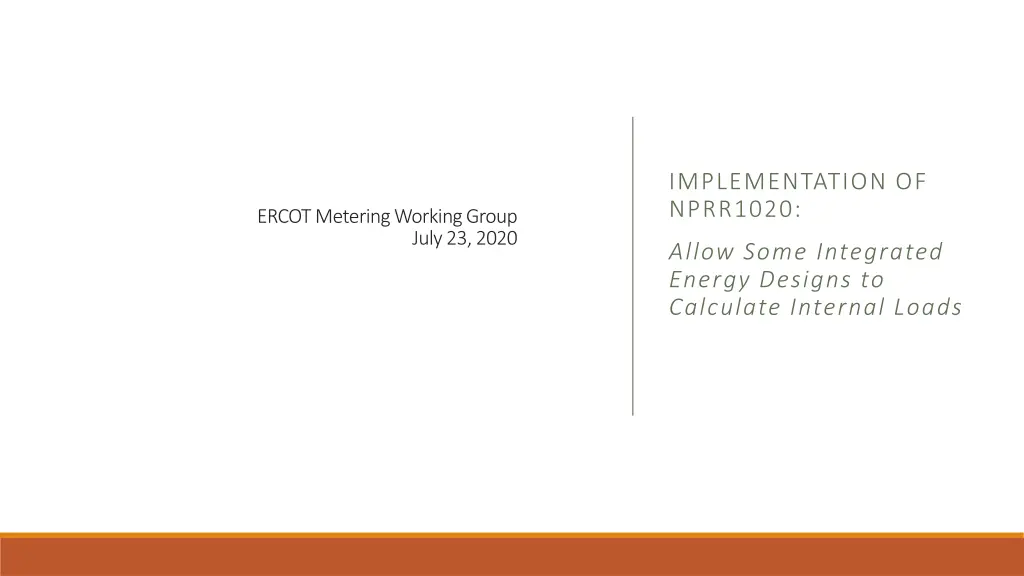
NPRR1020 Implementation for Integrated Energy Designs Calculation
"Explore the implementation of NPRR1020 by ERCOT Metering Working Group for allowing certain integrated energy designs to calculate internal loads accurately using advanced measurement processes and network architecture for efficient energy reporting and settlement data. Learn about the proposed implementation steps and key requirements for ERCOT approval. Discover the complex system of power conversion, monitoring, and reporting procedures involved in this innovative energy design approach."
Download Presentation

Please find below an Image/Link to download the presentation.
The content on the website is provided AS IS for your information and personal use only. It may not be sold, licensed, or shared on other websites without obtaining consent from the author. If you encounter any issues during the download, it is possible that the publisher has removed the file from their server.
You are allowed to download the files provided on this website for personal or commercial use, subject to the condition that they are used lawfully. All files are the property of their respective owners.
The content on the website is provided AS IS for your information and personal use only. It may not be sold, licensed, or shared on other websites without obtaining consent from the author.
E N D
Presentation Transcript
IMPLEMENTATION OF NPRR1020: ERCOT Metering Working Group July 23, 2020 Allow Some Integrated Energy Designs to Calculate Internal Loads
Integrated energy use (thermal and controller energy) measurement process Utility grid AC power is delivered from the utility grid via Powerstages with AC to DC conversion efficiency PS AC Breaker Powerstages Integrated energy use (thermal and controller) power consumption is calculated in each supply, based on real time voltage and current measurements with +/-2% accuracy. DC/DC integrated energy use voltage and current are sensed on the output side, hence conversion efficiency DCDC needs to be applied. V, I DC/DC Supply DC/AC Supply V, I Total integrated energy use supplied by the utility grid: AC power = (DC/AC supply + (DC/DC supply x 1/ DCDC)) x 1/ PS This power is reported from each Megapack to the Site Master Controller where it is aggregated to a single consumption value 2
Network architecture for load energy reporting through SCADA system ERCOT Each Megapack independently assesses its load power MV90 The site controller polls this information on a 10hz update rate, and sums across all Megapacks EPS Meter DATA CONCENTRATOR TDSP network RTAC pulls the calculated aux load from Tesla site controller and pushes calculated signal to TDSP owned EPS meter via TDSP data concentrator Generator Owner network DNP Over Single Serial Cable Calculated aux load Tesla Site Controller RTAC LAN 2 Switch LAN 1 Switch The EPS Metering integrates power into energy and reports settlement data on 15 minute intervals via MV90 polled by ERCOT (EPS Metering reports 3 separate channels: actual metered load, corrected load (subtracting aux power), and calculated aux load. 3 Local Historian Megapack 1 Megapack n 3
Proposed NPRR1020 Implementation Steps Proof of Concept Steps Resource Entity actions completed: Tested linkage from RTAC to MV90 Meter ( examples: SEL-735; Schneider ION ) TDSP actions completed by 7/30: Tested communication between RTAC, Data Concentrator and EPS Meter to verify 15-min interval value in the meter and historization Items to Implement in Settlement Metering Operating Guide Metering Arrangement Description Reference Resource Entity ESR Certification Form (pro forma or legal letterhead with certified diagrammatic attachment) State that ESR integrated loads cannot be metered separately as designed Submitted to ERCOT as part of EPS Metering Design package in normal resource entity registration/commissioning process Calculation Requirements & ERCOT Approval of Calculation Methodology Equipment used to measure the aux loads (DC transducers; master controller; battery plant RTAC) and associated software programming Methodology for using the data from the sensors (describe data flow from ESR readings to site controller to local historian and RTAC) Details of the Audit Process steps + reference annual attestation Attestation (include in SMOG Appendix or separately include on Settlement Metering landing page) Develop ERCOT recurring submission process (e.g. ERCOT market notices); change control process for affidavit form) 5
Attestation (2) An officer of the Resource Entity shall annually attest to the methodology and validity of the auxiliary Load calculation, as further described in the SMOG. The Resource Entity shall include with their annual attestation an independent audit performed by a registered Texas Professional Engineer of the performance of the internal sensors to prove the ESR has demonstrated one of the following: (a) The accuracy of the internal sensors, based on laboratory testing of the same model of internal sensors, which accounts for any possible degradation in accuracy over time. The attestation shall either state that the internal sensors have maintained +/ 2% accuracy or state that the Resource Entity has increased the calculated Load to account for any laboratory found inaccuracies for the attestation period; (b) +/ 2% accuracy measurement of the auxiliary Load via historical data for the past year; or (c) maintain +/ 2% accuracy or demonstrate via the Resource Entity s audit that the calculated meter data provided was at 98% of intervals maintaining an accuracy greater than 2% to compensate for any uncertainty of actual value of the auxiliary Load. Any ESR that utilizes internal sensors and is either not able to 7
Resource Entity Certification 10.2.4 Auxiliary Load Values Resource Entity Calculation and Telemetry of ESR (1) interconnecting TDSP confirms by approving the metering design, and, based on the information provided by the TDSP as part of the EPS Design Proposal, ERCOT agrees that metering of an ESR s Wholesale Storage Load separate from the ESR s auxiliary Load is not feasible based on the ESR s physical design, the Resource Entity for that ESR shall be permitted to calculate the auxiliary Load using measurements from its own internal sensors and telemeter a Real-Time aggregated value for that Load to the TDSP s EPS Meter. The Resource Entity may telemeter a zero Load value only when the ESR is discharging. The methodology by which the auxiliary Load is calculated is subject to ERCOT approval. When the Resource Entity certifies, the Submit ESR metering configuration worksheet + certification statement to TDSP in Metering Design Package

